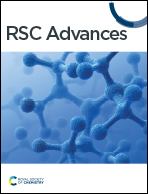LED-induced Ru-photoredox Pd-catalyzed C–H arylation of (6-phenylpyridin-2-yl)pyrimidines and heteroaryl counterparts†
Abstract
N-heterocycles are essential building blocks and scaffolds in medicinal chemistry. A Pd-catalyzed, Ru-photoredox-mediated C–H arylation is applied herein, for converting a series of functionality-inclusive (6-phenylpyridin-2-yl)pyrimidines to single arylated derivatives, using phenyldiazonium tetrafluoroborate as aryl source. This green chemistry-compliant transformation is induced by LED light. The drug-like modular substrates are constructed via combination of Biginelli multi-component condensation and Suzuki C–C cross-coupling, in order to strategically install, adjacent to the Ph-ring intended to undergo C–H arylation, a (6-pyridin-2-yl)pyrimidine that plays the role of a chelating directing moiety for the C–H arylation catalyst. The scope has been demonstrated on a series of 26 substrates, comprising diverse Ph-ring substituents and substitution patterns, as well as with 13 different aryl donors. Substrates in which the Ph-ring (arylation acceptor) was replaced by an electron-rich heteroaryl counterpart (2-/3-thiophene or -benzofuran) have also been examined and found to undergo arylation regioselectively. End-product conformations afford interesting motifs for occupying 3D chemical space, as implied by single-crystal X-ray diffraction, which has allowed the elucidation of six structures of aryl derivatives and one of an unprecedented pyrimidine-pyridine-benzofuran carbopalladated complex, believed to be a C–H activation derivative.



 Please wait while we load your content...
Please wait while we load your content...